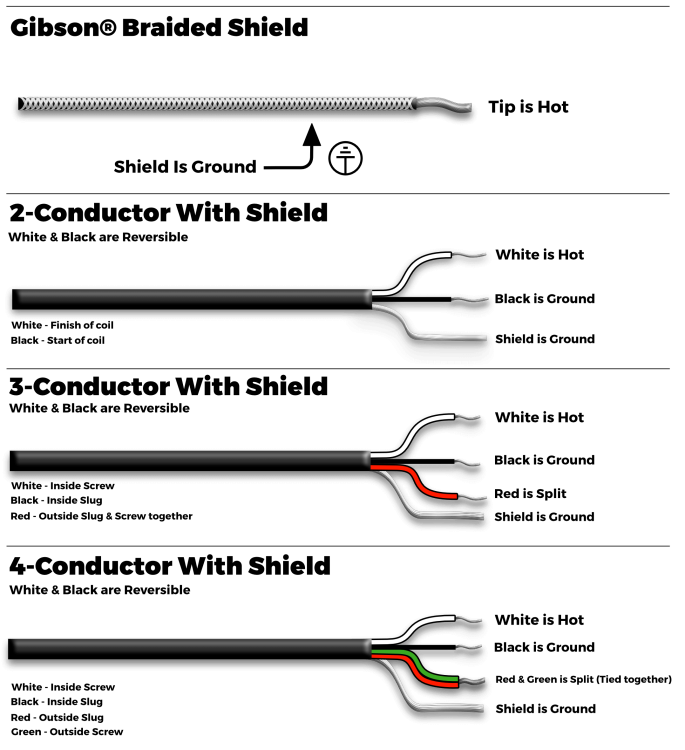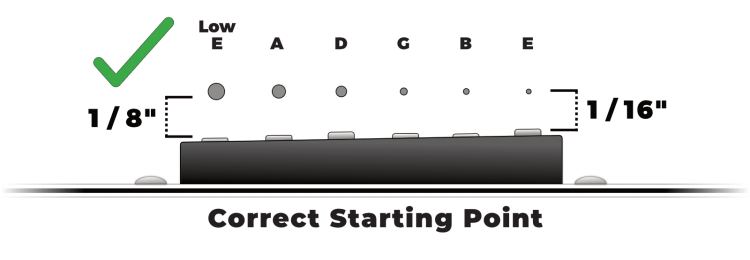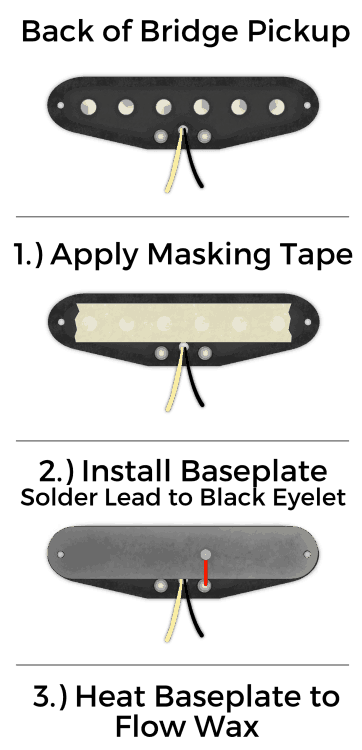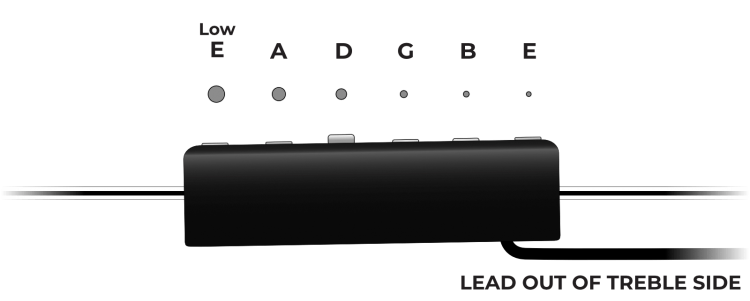FAQs
Browse all Frequently Asked Questions we get at Fralin Pickups. Check out Frequently Asked Questions regarding pickup installation, wiring, commonly used terms, and more!
Account
Frequently asked questions regarding signing in and managing your account
In order to use our Wishlist, you'll need an account. You can only create an account by shopping with us at this time. If you have an account:
- Log in your account
- Select your product options (all options need to be selected)
- Click "Add to Wishlist"
Your Wishlist items appear in your account.
You need to have an account before changing your address. Once you have an account, log in to your account and select the “Addresses” tab to change your Address.
No. All accounts are created at the time of purchase.
You can create an account on the checkout screen by checking the box below and proceeding to checkout with your order. An account will be created for you after you set a password. The email address you used will be your login ID.
Create an Account Checkbox

Create a Password Field

Billing
Frequently asked questions regarding billing and payment
We do not store any Credit / Debit card information. The only information we store is your:
- Billing & Shipping address and name
- Email Address for communication
- Phone Number for communication
We take the following payment methods:
- All major Debit or Credit cards
- PayPal
- Apple Pay
- Google Pay
- Venmo
- Fralin Pickups Gift Cards
General
General frequently asked questions
Our pickups feature a 10-year warranty on manufacturing defects. Examples of a warranty claim may include:
- Pickup suddenly stops working
- Pickup’s output decreases
- Microphonics are more noticeable and frequent
Warranty does not include negligence by the customer when handling or installing pickups.
Our Control Plates and Prewired Pickguards feature a 1-year warranty on electronics (pickups still feature a 10-year warranty). Electronics (pots, switches, jacks) are not covered after 1 Year of purchase date.
Fralin Pickups will accept a one-time exchange for orders that meet the following criteria:
- Customized pickups are not eligible for exchange or return.
- The exchange must be within 30 days of receiving the pickup(s).
- The exchange must be for tonal reasons. Due to a lack of proper research on the customer’s behalf, exchanges are ineligible.
- Pickup(s) must be in new and unaltered condition. If Fralin Pickups finds damage on the original pickup(s), we may charge additional fees to fix or replace the damaged pickup(s) or parts.
- The customer is responsible for the original pickup(s) return shipping and the new shipping costs incurred for the exchanged pickup(s).
- The customer is responsible for shipping the pickup(s) safely using adequate packing materials.
- The original order must have been placed through Fralin Pickups, not one of our authorized resellers.
To proceed with an exchange, you must perform the following tasks:
- Contact us before sending in an exchange to authorize it
- Complete the Exchange Form and write the RMA number clearly on the outside of the package
Fralin Pickups must authorize a return before proceeding.
If a return is authorized, Fralin Pickups will deduct a 10% restocking fee from the refunded amount on products eligible for return, minus original shipping costs. Additionally, we may deduct additional funds from the refunded amount if the original pickups exhibit damage, scratched covers, or require general refurbishing. We will assess these fees upon the arrival of the returned pickups and a careful inspection.
Customized pickups and products from our Prewired catalog are ineligible for return or exchange.
All mail and packages may be sent to:
Fralin Pickups
2015 W. Laburnum Ave, Fl. 2nd
Richmond, VA 23227
Please note that you must Contact Us before sending a Rewind or Repair.
If you want to become a re-seller or achieve lower pricing, you can fill out our Reseller Application. We’ll determine if you qualify.
We do! Please take a look at our Rewinds and Repairs page for further information.
Our shop hours:
- Monday – Thursday: 10-6 PM EST
- Friday: 10-5 PM EST
- Saturday: Closed
- Sunday: Closed
Orders
Frequently Asked Questions regarding orders and order status
If you don’t see what you want on the product page as an option (i.e., left-handed), please request on the ‘ORDER NOTES’ section on the checkout screen, or Contact Us to ensure we can accommodate your request.
As a company, we really try to avoid changes to your order. Please take your time ordering and contact us with any questions before placing your order. We work fast once we get your order, and changes really mess things up in the shop. That said, order changes can be made within 24 hours of placing the order. If a critical change must be made, some or more of the following circumstances may apply:
- You may be charged a restocking fee if your original order is close to shipping
- You may be charged twice for covers if you change the cover choice and the original covers are installed (this does not apply to plastic covers)
- Your order will likely get bumped to the end of the production queue, and your lead time will start over
It depends! Some pickups take longer to make and have a higher volume of sales. Select all the options you want on the product screen, and the estimated lead time will display before the price. For orders already in production, our lead times are pretty accurate. Please be patient as we hand-build orders to spec on a first-come, first-served basis.
Product Questions
Frequently Asked Questions regarding products, and our general product offering
The type of lead you choose is very important for a breezy and successful installation of your pickups. Here are some golden rules of thumb:
- If you're buying a single pickup, you should always purchase your pickup with a reversible lead if possible. Select 2-Conductor or 3-Conductor. This will allow you to reverse the phase if need be.
- Instruments with Blade Switches (think Fender Telecaster or Stratocaster) should avoid using Gibson Braided lead. It makes the installation a bit more challenging.
- Don't select a 4-conductor lead unless you need it. It can be a headache to install for novices.
- Gibson Braided Lead is ideal for pickups purchased as a set and installed in a Gibson-style instrument with 2 Volume Pots.

If you're unsure of what these numbers mean, they are standardized String Spacings for guitar pickups. In essence:
- 49.2mm: Standard Gibson Spacing. Used on Les Pauls, Standard, SG's, 335's - anything with a Tune-o-Matic or ABR-1 Bridge.
- 50mm: Fender Neck Spacing - Used on Neck pickups for a Fender Telecaster, Jazzmaster, Stratocasters, and more.
- 52mm: Fender Bridge Spacing - Used on Bridge pickups for Fender-style instruments.
Examples:
- Buying Humbuckers for a Les Paul? Use 49.2mm spacing on both pickups.
- Buying Humbuckers for a Stratocaster? Use a 50mm Neck and 52mm Bridge spacing.
Our -5% Underwind is our ’70s Jazz Bass output. Select “5% Underwind” for your output.
The Stock Output best resembles the "60s" Jazz Bass Sound.
Starting November 2023, we’ve started adding our new and improved sound clips, and comparing Sound Clips is easier than ever before!
Not all products have our new Sound Clips, which display as a Playlist. If a product does have a new Sound Clip, it will have a button that says “Compare Sound.” Click up to three products and click “Compare” on the action menu.
If you don’t see a “Compare Sound” button, head to the product page and click on the “Sound” tab. Most products have single Sound Clips.
Here’s an example:

No – all Big T purchases are done through Analog Man.
Yes, all pickup purchases come with all the necessary hardware to mount your pickups to your set up. We do not include foam for Jazz Bass or P-Bass pickups.
Unlike other pickup manufacturers, we absolutely do custom work. However, our scope is limited to what we already manufacture. Contact us and let us know what you’re thinking, and we’ll let you know what’s possible!
Shipping
Frequently Asked Questions regarding shipping and product delivery
Contact us immediately, and we'll start a claim with the shipping provider. If the provider cannot trace or locate the package in a reasonable amount of time, we'll consider it a loss and we'll remake your order as quickly as we can.
We're sorry to hear that - thieves are the worst! If your package is stolen, we recommend filing a police report with your local authorities. There's not much we can do on our end, but we may discount your new order a bit should you choose to re-order.
For Domestic Deliveries:
- All parts and accessories usually ship US Priority Mail – $10.
- Pickups, Prewired Pickguards, and Control Plates ship UPS Ground – $16.
Alaska, Hawaii & Canada:
- UPS 2-Day (Alaska, Hawaii) – $35
- UPS Worldwide International – $35
For The Rest Of The World:
- All other orders ship UPS Worldwide International – $50
We reserve the right to choose the appropriate method of shipment at the time of shipment.
Technical Questions
Frequently asked questions regarding technical information about pickups and products
Storing your old or unused pickups is a straightforward process, and we've got a whole article on the subject! Check it out here
While pickup polarity can seem daunting to understand, it's actually quite simple: a pickup will either "Push" or "Pull" the speaker when it's signal gets there. If two pickups are out of phase and their signals are combined (think middle position of a Telecaster), one pickup is trying to "push" the speaker, while the other "pulls" the speaker.
This "Tug of war" results in the Out of Phase tone, which sounds thin, brittle, and nasally.
Identifying your pickup's polarity can be a bit tricky, but is still quite simple to understand. All pickups have two things that will determine it's polarity: Wind Direction and Magnet Polarity.
Humbuckers and Hum Cancelling pickups have Both Magnet Polarities in them (a humbucker has a North coil and a South coil). So, all you need to worry about with a Humbucker is getting one with Reversible Leads, like a 2-Conductor or 3 Conductor lead. If you have a Humbucker with reversible leads and you experience an out of phase tone, simply reverse the leads and you'll be back in phase.
Single Coils are a bit trickier - so we've written an article on that subject here - check it out.
All of our models have a "Stock" output, which is the output Lindy recommends. That said, we can customize your wind by adding or removing turns of wire.
Generally speaking, a pickup that is "Overwound" has a touch more output and sounds thicker and darker when compared to the Stock output.
A pickup that is "Underwound" sounds clearer with a scooped midrange.
Our traditional Stratocaster and Telecaster pickups can select “Magnet Stagger.”
Understanding and identifying your guitar’s Fingerboard Radius is essential before determining Magnet Stagger. Magnet Stagger is the magnet or pole piece height pattern under each string. We have different pickup staggers optimized for different fingerboard radiuses: a “Stock” stagger for rounder radiuses (7.25? – 9.5?) and a “Hybrid” stagger for flatter and compound radiuses (10?+). Each stagger optimizes the string-to-string balance of the pickup. See below for a comparison of our Magnet Staggers:


Follow our in-depth guide to checking your String Spacing here.
Pickups built with Alnico Rods (Stratocaster, Telecaster, Mustang) pull on the strings more than other designs; for this reason, they may need to be farther away. We suggest that you follow our in-depth guide on pickup height here.
Note: Split Blades sound best a little closer to the strings than a standard Strat or Telecaster pickup. Split Blades don’t pull your strings out of tune like a regular pickup, either. Feel free to get our Split Blades close to the strings – you’ll love their tone when you do.
To properly set pickup height, follow these steps:
- Measure by holding the Low E string down at the highest fret
- Measure from the top of the Low E pole piece to the bottom of the string – the ideal distance is 1/8?, or 3.2mm.
- Perform the above steps on the High E string. The ideal distance on the treble side is 1/16?, or 1.6mm.

You’d know it if you heard it! “Out of phase” refers to combining two out-of-phase pickups together (think of the middle position of Tele). The tone is usually described as weak, hollow, and thin. Learn more about phase here!
Note: Out of Phase is different from Parallel. For example, the middle position of a Telecaster is wired in parallel. This gives the pickups a “quack” tone that we all know and love. Out of phase is different and sounds hollow and thin.
Not all the time. Check out this article here: What does Resistance mean for guitar pickups?
Installation
Frequently asked questions regarding installation of guitar and bass pickups
General
General Frequently Asked Questions regarding Installation - get answers to General install questions here
Follow these simple steps below to install our Baseplate on the back of a Stratocaster Bridge Pickup:

We ship two sets of screws with a Telecaster neck pickup –
- Wood Screws (for mounting directly into the wood of the body)
- Machine Screws (For mounting to the pickguard).
Machine Screw:

If mounting to a pickguard, Do Not Overtighten. Doing so can strip the fiberboard.
Wood Screw:

We sure do. Check them out at our Wiring Diagrams page, linked below:
Installation Tips By Pickup Category
Installation Tips, separated by pickup category! Get category-specific tips on Stratocasters, Telecasters, and more!
Check out linked page below for our full article on Telecaster® Installation Tips:
Check out linked page below for our full article on Stratocaster® Installation Tips:
Pickup Installation
Frequently Asked Questions regarding Pickup Installation. Discover Tips, Tricks, and Best Practices here.
As it turns out, we currently do not feature any Gibson quick-connect compatibility.
However, removing the Quick Connect system entirely and replacing it with a standard soldered wiring harness is advisable. You can expect better results in tone and peace of mind knowing the soldered harness will last much longer than the plastic clips – they are the weakest link in your signal chain. Check our wiring diagrams below:
To properly set pickup height, follow these steps:
- Measure by holding the Low E string down at the highest fret
- Measure from the top of the Low E pole piece to the bottom of the string – the ideal distance is 1/8?, or 3.2mm.
- Perform the above steps on the High E string. The ideal distance on the treble side is 1/16?, or 1.6mm.

On P90s, Jazzmasters, and Humbuckers, the lead comes out of the Treble Side of the guitar. In other words, the lead will be closest to the G, B, and E strings.
Most Alnico pickups have a raised magnet – this magnet goes under the D string, not the G string.

For Neck Position Humbuckers, the lead comes out of the Bass Side.
Pickup Wiring
Questions regarding pickup wiring and soldering. Get answers to your Pickup Wiring questions here!
Humbucker Color Codes are very important to understand. Check out our in-depth article on the subject here:
We install this wire on all of our Fender models, and it is straightforward to use. To use this wire, push the cloth insulator back to expose enough of the wire’s core. Tips on that:
- Get the wire straight before pushing back the cloth insulation
- With one hand, hold the wire about an inch from where you intend to expose the wire core
- With the other hand, carefully pinch the tip of the wire and push back to expose the wire core slowly
- Lastly, if the wire bends, repeat step 1 and try again
A 3-wire pickup configuration is a courtesy to the customer as it allows you to quickly reverse the coil direction or phase of the pickup. Our standard wiring is:
- White = Hot (to switch)
- Black = ground
In a 3-wire setup, you have:
- White = Hot (reversible)
- Black = ground (reversible)
- Blue = Chassis Ground (permanent ground)
If you followed the above wiring and notice that your pickup is out of phase with another pickup, reverse White & Black to put your pickup back in phase.

Oh yeah! We’re masters at soldering. Check the linked page below:
Troubleshooting
Frequently Asked Questions regarding Troubleshooting Guitar Pickup Installs. Having issues? Check here!
If you are experiencing buzzing with your guitar or bass, it helps to break the noise into the correct category before diagnosing the issue. There are two primary types of Buzz you can encounter:
- 60-Cycle Hum
- Buzz caused by a bad ground connection
Let’s break them down:
60-Cycle Hum is a common phenomenon with Single Coil Pickups, and depending on your environment, it can be mild to severe. Causes of 60-Cycle Hum include computer monitors, cell phones, dimmer switches, radio towers, and bad electrical wiring in your house.
Furthermore, it’s not just the pickups that can pick up 60-cycle hum, but your cables, pedals, and amp can also pick up the buzz. If you use a lot of pedals, including compression and distortion or overdrive pedals, expect the noise floor to be worse when turning the pedal on.
To verify that you are experiencing a 60-cycle hum, sit in an office chair that can swivel and slowly rotate around your room while holding the guitar plugged into your amp. You should notice the hum is worse at some points in the room than others – this is normal.
Steps to mitigate 60-cycle hum:
- Add shielding to the guitar’s electronic cavities
- Change amp position – placing your amp directly against the wall can pick up 60-cycle hum
- Change the angle at which you sit and play in your room to find the spots where the hum is the least prevalent.
- Upgrading your cables can help reduce the noise floor of your signal chain
- While not ideal tonally speaking, a noise gate pedal can help in extreme situations
You can describe the symptoms of Buzz caused by a faulty ground circuit as follows:
- Persistent buzz regardless of sitting position
- Louder buzz, not like 60-Cycle Hum
- Touching metal parts on the guitar causes the noise to drop in volume or completely disappear
Buzz caused by ground issues is common, especially with novice technicians not well-versed in guitar wiring. In this scenario, at least one metal part on the guitar is not grounded correctly. The leading causes of this issue are a cold solder joint or loose wire. Ground issues can be quite simple to fix if you understand how to hunt them down. Check out our article on finding and fixing ground issues here:
